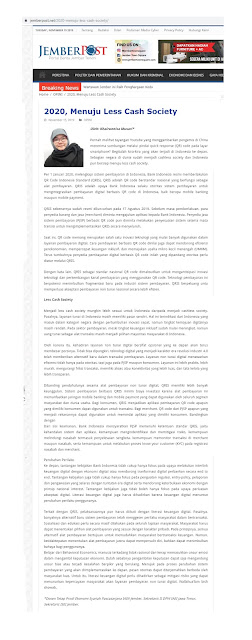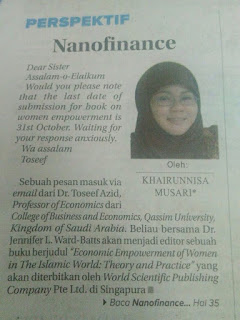A New Sphere of Sukuk: Linking the Pandemic to the Paris Agreement (The World Financial Review, Finance & Banking, December 28th, 2020)
https://worldfinancialreview.com/a-new-sphere-of-sukuk-linking-the-pandemic-to-the-paris-agreement/
By Greget Kalla Buana and Khairunnisa Musari
The number of reported COVID-19 cases is approaching 50 million
across the globe, and the death toll has passed a million. Not only does it
bring about severe health issues, but also economic, social and political
instability. However, the environmental perspective seems to be a different
story.
Apart from the pandemic, 2020 also marks the entry into force of
the Paris Agreement, an accord within the United Nations Framework Convention
on Climate Change (UNFCCC), signed five years ago in Paris. Adopted by 197
countries, this agreement was to tackle climate change and its negative impacts
by means of mitigation, adaptation and finance, with the main objective of
limiting global temperature rise to below 2 degrees Celsius.
Being among countries that have ratified the agreement,
Indonesia is required to prepare, communicate and maintain successive
Nationally Determined Contributions (NDCs) that it intends to achieve.
Indonesia’s NDC outlines the country’s transition to a low-carbon and
climate-resilience future and the commitment to reduce 29 percent of its
greenhouse gas emissions, representing a reduction of up to 41 percent against
the business-as-usual scenario, subject to the availability of international
support for finance, technology transfer and development, and capacity-building.
So
what is the connection between the pandemic and the agreement?
The World Economic Forum has cited 11 visualisations from NASA’s
Global Modeling and Data Assimilation showing the dramatic knock-on effect of
lockdowns, quarantining and travel restrictions on air quality in China, South
Korea, Italy and India. There has been a sharp drop in carbon dioxide (CO2) levels in the most
polluted capitals due to the shutdown of factories, industries and
transportation.
The pandemic is predicted to result in a record annual decline
in carbon emissions of almost 8 percent, as reported in the International
Energy Agency’s Global Energy Review. Global energy demand, especially for
coal, oil and gas, falls by 6 percent, which is comparable to India’s total
energy demand as the world’s third-largest energy consumer, and is equivalent
to seven times the decline in the aftermath of the 2008 financial crisis, and
the biggest shock since the Second World War.
In a similar shift, the air quality in Jakarta was moderate,
according to the air quality index at the time the first wave of large-scale
social restrictions (PSBB) was implemented. The city’s air quality used to have
an index of 160 and, hence, was classified as “unhealthy”.
Indeed, miraculously, a decrease in the concentration of nitrogen
dioxide (NO2) has changed the
environmental conditions during the pandemic, as happened in Paris, Madrid and
Rome, according to observations from the European Space Agency’s Copernicus
Sentinel-5P satellite. It also detected plummeting levels of NO2 across China
following the economic slowdown.
Looking at the bright side, it is undeniable that the pandemic
has generated ‘positive’ outcomes with regard to the impact of climate change.
In addition to misery, hardship and suffering, COVID-19 has also given rise to
clear water and blue skies.
The pandemic and climate change both call for a “flattening of
the curve”. The question remains, when the pandemic is over and humans get back
to normal, will climate change worsen again? It depends on how societies adopt
new habits to jointly address the two crises at once.
Innovative
financing through Sukuk
In line with Sustainable Development Goals (SDGs), a financing
gap stands in the way of implementing the Paris Agreement. An estimated
US$1.6-3.8 trillion annually between 2016 and 2050 is needed to achieve the
transition to low carbon. This figure refers to supply-side energy system
investment alone (IPCC, 2018).
Attracting sufficient funding is one thing, but getting that
funding to where it is supposed to be is something else. There must be a step
change to pull money back into real economies – innovative financing. To this
end, the drive for a green economy and green financing is echoed in many
countries, including Indonesia.
In this context, the government of Indonesia committed to
applying mainstream green economy principles to development planning in order
to promote the SDGs, including taking steps towards the implementation of green
financing for the banking industry through the Financial Services Authority (OJK).
The government allocated IDR728 trillion (~US$51 billion) for
mitigation and adaptation actions in 2015-19 (NDC, 2017). However, with
projected financing standing at IDR1,065 trillion (~US$75 billion) (TNC, 2017),
there is a gap in finance. In response to this, a sovereign Green Sukuk was
issued in 2018-20 with a total of US$2.75 billion, the proceeds of which are
leveraged to finance a list of eligible green projects in nine sectors, such as
renewable energy, climate resilience for disaster-prone areas, and waste and
waste energy management.
The very first sovereign Green Sukuk issued in the world has
opened the doors to more participation from investors – those whose intention
is to generate financial returns and those who are impact-oriented. The nature
of sukuk indicates partial ownership by its holders over underlying assets or
projects, which are backed by the government, making this kind of Islamic
instrument more favourable. Unlike the regular variant, the Green Sukuk entails
an annual impact-measurement report. This mechanism is suited to the concept of
impact investment, which considers social and environmental impacts as its
benchmarks.
Despite being innovative, the three greens (economy, financing
and instrument) exclude certain sectors from their framework, which triggers
new constructs, one of which is the blue economy.
The World Bank defines blue economy as the sustainable use of
ocean resources for economic growth, improved livelihoods and jobs, while
preserving the health of the ocean ecosystem. Going beyond conservation,
fisheries or aquaculture, the blue economy also covers tourism, mining,
transportation and marine infrastructure development, some of which have been
hit by COVID-19.
The blue economy equally plays an important role in reducing
carbon. Having said this, the notion of blue carbon – carbon produced
underwater and stored in oceans and coasts – for lowering global emissions has
not been widely discussed. Using the same approach as the green framework, a
Blue Sukuk for the marine and fisheries sectors has begun to be considered in
Indonesia, where the Blue Financial Framework is being eagerly pushed forward.
Law No. 19/2008 on Indonesian Sovereign Sukuk (SBSN) clarifies
that an object and/or state-owned property that has economic value can be used
as the basis for the issuance of SBSN, meaning that natural resources (land,
sea, air) are considered to be prospective underlying assets. The aerospace
sector requires further exploration. In reality, the aviation industry and
information and communication technology each contributed a minimum of 2
percent carbon emissions, according to the Air Transport Action Group and the
International Telecommunication Union.
A country’s air territory is the domain of flight traffic. In
recent years, air transportation has shown its concern about climate-related
subjects by initiating zero-carbon flights. In addition, the radio-frequency
spectrum and electromagnetic waves from transmitters, radars and satellites
propagate through the air. Thus, airspace is a strategic resource.
Identical to Green and Blue Sukuk, the aforementioned areas of
airspace and their development have the potential to be underlying assets and
projects for the issuance of White Sukuk, strengthening the air sectors and
associated industries.
Is it still worth exploring, if not many people feel directly
connected to airspace? Let’s take a look at the work-from-home arrangements
that have been set up in the course of the COVID-19 pandemic.
Currently, the world is facing a new equilibrium because of
physical and social restrictions. Nearly all activities are carried out
remotely. In this particular case, technology becomes crucial. The pandemic has
demonstrated the importance of telecommunications infrastructure in keeping
governments, business, societies and individuals in operation. Humans are
highly dependent on technology as a source of information and as a tool for
distance learning and working from home.
Although they experienced a significant stock market correction
during the pandemic, listed companies in the Asia Pacific regional
telecommunications sector are projected to remain resilient, with minimal
impact on performance, since the public interest for data and information
access continues to increase. The sector has proven its essential nature in
serving domestic economies in a connected world and, hence, boosting investor
appetite for infrastructure funds.
In the near future, the surge in demand for the Internet will
trigger the application of microwave spectrum technology through such
innovations as direct-broadcast satellites, wireless networks, and the emerging
5G to support high-speed connectivity and data-intensive applications. No fewer
than 98 percent of people in Indonesia rely on mobile data to connect to the
Internet.
This phenomenon points to the possibilities of White Sukuk in
entering the market. With the support of a fatwa from the National Sharia Board
of the Indonesian Council of Ulama (DSN-MUI) and government regulations, the
issuance of White Sukuk is feasible. Notwithstanding the national economic
downturn, this breakthrough helps maintain fiscal and monetary sustainability
by optimising local resources and supporting the deepening of an inclusive
Islamic financial market.
Three sectors have been severely hit by COVID-19, namely
tourism, transportation and agriculture. The issuance of the three-coloured
sukuk is attainable in order to finance post-pandemic recovery.
Islamic finance is confronted with the challenge of offering
liquidity instruments that can be utilised at any time of disaster or any other
emergency situation. Innovation in the area of sukuk is expected to answer this
challenge.



Komentar
Posting Komentar